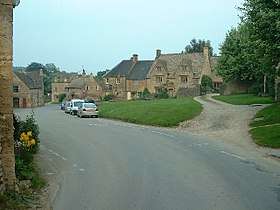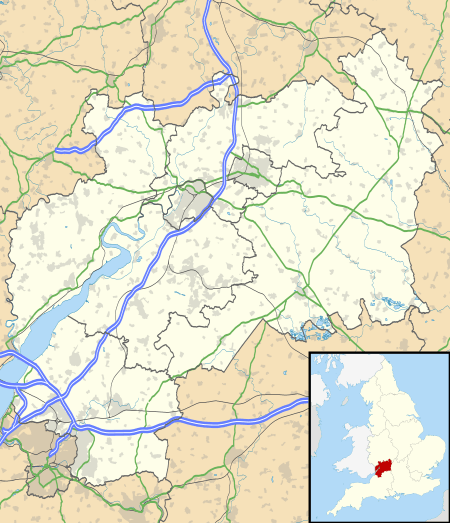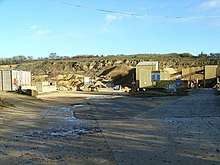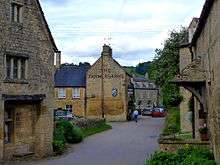Guiting Power
Guiting Power is a small Gloucestershire village in the Cotswolds, England. The population taken at the 2011 census was 296.[1]
| Guiting Power | |
|---|---|
 Guiting Power, looking south-east down the village | |
 Guiting Power Location within Gloucestershire | |
| Population | 296 (2011 Census) |
| District | |
| Shire county | |
| Region | |
| Country | England |
| Sovereign state | United Kingdom |
| Post town | Cheltenham |
| Postcode district | GL54 |
| Police | Gloucestershire |
| Fire | Gloucestershire |
| Ambulance | South Western |
| UK Parliament | |
In 1968, The Manor lands and over half of the homes were purchased by Raymond Cochrane, who intended to renovate and develop the infrastructure. In the 1970s, he formed the Guiting Manor Amenity Trust, a charitable trust, to oversee the village after his death. The trust manages the village and rents out some of the 67 houses that it owns at moderate prices.[2][3]
Location
Guiting Power is situated on the slopes above a small valley (formed by a tributary of the River Windrush). There was a late Anglo-Saxon settlement on this site, when it was called Gyting Broc. The village is situated midway between Cheltenham and Stow-on-the-Wold, and the parish church is located at Ordnance Survey grid reference SP 096246.
History
Research indicates that there has been a settlement in the area since 780 or perhaps earlier. Excavations have revealed Iron Age activity, a Roman figurine, a small Saxon sarcophagus and the remains of a very early Saxo-Norman chapel.
The village was based on a manor owned by King Edward (the Confessor) but had declined by the time of the Domsday Book of 1086. The second word of the name comes from the lords lePohers while Guiting comes from the Saxon word getinge, for rushing, perhaps referring the Windrush River.[4]
In 1872, the population was 647; there were 161 homes. The manor was owned by J. Walker. The church was in good condition; at the time, there was also a Baptist chapel.[5] A brass plaque in the church is dedicated to John Walker, 'Lord of the Manor' and is dated 1712.[6]

The area includes abandoned quarries where the "yellow" and "white Guiting" limestone was mined; other areas of the Cotswolds more often used the oolite stone.[7] Quarries in nearby villages still produce this type of stone.[8]
By the 1950s, the village was run down because of a depression in the farming industry. By that time, 12 cottages had been purchased by Moyra Davidson (in the 1930s)[9] for renovation and these, plus other buildings were subsequently bought by Raymond Cochrane. Many of the properties have been renovated by the Trust.[10]
Facilities and features
The village is unusual for its size in having a Post Office, a village hall, a children's nursery, a bakery, village shop and two public houses. Nearby are the excavated foundations of the original Anglo-Saxon church and a large kerbed round barrow shown as tumulus on Ordnance Survey mapping.[11] To a large extent, the village owes its preservation to the Guiting Manor Amenity Trust.

The Wardens' Way passes through the village, on its 14-mile (23 km) route from Bourton-on-the-Water to Winchcombe, passing close by the church. It joins the Oxfordshire Way to the Cotswold Way and can be combined with the Windrush Way to make a circular route. It passes through the Cotswold villages of Guiting Power, Naunton, Lower Slaughter and Upper Slaughter.
There is a 17-acre (69,000 m2) wetland nature reserve, where a rich flora and fauna thrive.
The village School (built in 1872) was closed down and was purchased by the Trust; it was then converted into the village playschool for residents' children.[2]
The Trust also owns a farming community rented to its subsidiary, Guiting Manor Farms Ltd which specializes in sustainable food production. Various crops are grown and sheep are raised on the 580 acres;[12] the lambs are sold for meat.[13]
The nearby Cotswolds Farm Park, privately owned by Adam Henson,[14] is a tourist attraction with 50 breeds of farm animals. The facility also operates a campsite with spots ("pitches") for campers, 14 with electricity.[15][16]
Religion
The parish church of St Michael and All Angels is situated on the south edge of the village. It is of Norman origin, with a later Victorian transept. The north and south doorways were preserved in the renovations at that time. Extensive remodeling took place in the 13th and 15th centuries and the church was enlarged in the first half of the 1800s.[17] The 12th century chancel was extensively modified in 1903.The church is in the National Heritage List for England as a designated Grade II listed building (List entry Number: 1089532, June 1980).[18][7]
St Michael's is part of the Benefice of the Seven Churches which also includes Temple Guiting, Cutsdean, Farmcote, Lower Slaughter with Eyford, Upper Slaughter and Naunton.[19]
"Guiting Power" is a hymn tune by John Barnard, named after the village, for the hymn "Christ triumphant, ever reigning".
Guiting Music Festival
The Guiting Music Festival (formerly the "Guiting Festival") was founded in 1970. It runs for ten days, starting in the last week of July every year.[20] It typically comprises eight evening concerts covering the genres of classical, folk and jazz. These are normally held in the Village Hall. Two open-air concerts are held in the adjacent playing fields on the first and second Sundays. It is a Registered Charity (No. 1100808).[21]
Notable residents
SAS soldier and author Lofty Large grew up in Guiting Power.[22]
Gallery
- Village road
- The barn
- Remains of Anglo-Saxon church
- Anglo-Saxon 'tumulus'
 St Michael's & All Angels, Guiting Power - Norman doorway
St Michael's & All Angels, Guiting Power - Norman doorway- Church tower
- The South door
References
- "Parish population 2011". Neighbourhood.statistics.gov.uk. Retrieved 25 March 2015.
- "Archived copy". Archived from the original on 23 June 2018. Retrieved 23 June 2018.CS1 maint: archived copy as title (link)
- Hall, Damian (30 April 2016). "Walking in the Cotswolds: 30 circular walks in the AONB". Cicerone Press Limited. Retrieved 12 May 2019 – via Google Books.
- "history". Guitingmanoramenitytrust.co.uk. Retrieved 12 May 2019.
- "History of Guiting Power, in Cotswold and Gloucestershire - Map and description". Visionofbritain.org.uk. Retrieved 12 May 2019.
- Historic England. "CHURCH OF ST MICHAEL, Guiting Power (1089532)". National Heritage List for England. Retrieved 12 May 2019.
- "Archived copy". Archived from the original on 23 June 2018. Retrieved 23 June 2018.CS1 maint: archived copy as title (link)
- "Appendix 11 - Natural Stone Quarries" (PDF). Westoxon.gov.uk. Retrieved 12 May 2019.
- "Guiting Power Tourist Information & Guide". Cotswolds.info. Retrieved 12 May 2019.
- Child, Mark (15 May 2010). "The Windrush Valley". Amberley Publishing Limited. Retrieved 12 May 2019 – via Google Books.
- "Guiting Power 3 round barrow". University of Bradford Division of Archaeological, Geographical and Environmental Sciences. 29 July 1998. Archived from the original on 23 December 2012. Retrieved 16 March 2008.
- Classroom, Countryside. "Guiting Manor Farms Ltd". Countrysideclassroom.org.uk. Retrieved 12 May 2019.
- "History of the Farm - Guiting Manor Farms Ltd". Guitingmanorfarms.co.uk. Retrieved 12 May 2019.
- "Adam Henson's Cotswold Farm Park - Guiting power - Days Out - The AA". Theaa.com. Retrieved 12 May 2019.
- "About - Adam Henson's Cotswold Farm Park". Cotswold Farm Park. Retrieved 12 May 2019.
- Outdoors, Digital. "Cotswold Farm Park Campsite in Cheltenham, Gloucestershire". Campsites.co.uk. Retrieved 12 May 2019.
- "Guiting Power, St Michael's Church, History & Photos - Historic Gloucestershire Guide". Britain Express. Retrieved 12 May 2019.
- Stuff, Good. "Church of St Michael, Guiting Power, Gloucestershire". Britishlistedbuildings.co.uk. Retrieved 12 May 2019.
- "Seven Churches". Guitingevents.co.uk. Retrieved 12 May 2019.
- Watts, Clare. "Guiting Festival 2019". The 48th Guiting Music Festival. Retrieved 12 May 2019.
- "Charity overview". Apps.charitycommission.gov.uk. Retrieved 12 May 2019.
- Large, Lofty (1999). Soldier against the odds. Mainstream Publishing. p. 117. ISBN 978-1-84018-346-7.
External links
| Wikimedia Commons has media related to Guiting Power. |